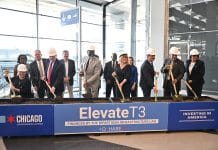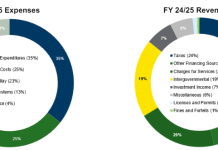Construction spending rose 4.1 percent from November 2018 to November 2019, while industry employment grew in 226, or 63 percent, out of 358 metro areas, according to a new analysis of federal data recently released by the Associated General Contractors of America (AGCA). Association officials noted that its recent survey found most contractors are optimistic about the dollar value of projects available and expect to keep adding workers in 2020 but they are finding it hard to fill positions and anticipate it will continue to be hard to hire employees.
Illinois didn’t fare so well, despite the national growth, with the largest percentage decline in the nation recorded in the Danville area, which lost 17 percent of its construction (along with mining and logging) employees. Of course, this is not a large market — the 100 person job loss is significant locally, but pales compared to the Chicagoland area (including Naperville and Arlington Heights) which lost 3,200 construction jobs in the year.
The most successful Illinois areas were in fact border communities shared with other states, including Davenport-Moline-Rock Island, (with Iowa) and the metropolitan St. Louis Missouri area.
Here is data for some Illinois communities. (Numbers are employment totals in Nov. 2018, Nov. 2019, the percentage change, the number of employees added (lost) and the national ranking.)
- Davenport-Moline-Rock Island, IA-IL Mining, Logging, and Construction 10,400 11,200 8% 800 26
- St. Louis, MO-IL Mining, Logging, and Construction 67,300 72,600 8% 5,300 26
- Champaign-Urbana, IL Mining, Logging, and Construction 3,500 3,700 6% 200 56
- Springfield, IL Mining, Logging, and Construction 3,600 3,800 6% 200 56
- Bloomington, IL Mining, Logging, and Construction 2,600 2,700 4% 100 119
- Lake County-Kenosha County, IL-WI Div. Construction 16,400 17,100 4% 700 119
- Elgin, IL Div. Construction 15,100 15,600 3% 500 155
- Rockford, IL Mining, Logging, and Construction 5,900 6,000 2% 100 183
- Decatur, IL Mining, Logging, and Construction 3,200 3,200 0% 0 227
- Kankakee, IL Mining, Logging, and Construction 1,400 1,400 0% 0 227
- Peoria, IL Mining, Logging, and Construction 7,600 7,500 -1% -100 285
- Chicago-Naperville-Arlington Heights, IL Div. Construction 134,000 130,900 -2% -3,100 298
- Danville, IL Mining, Logging, and Construction 600 500 -17% -100 358
“Both the actual spending totals for November and our members’ expectations for 2020 point to a continuing uptick in construction employment,” said Ken Simonson, the association’s chief economist. “It’s likely that even more metros would have added workers recently if unemployment weren’t at record lows in many areas.”
Construction spending totalled $1.324 trillion at a seasonally adjusted annual rate in November, up 0.6 percent from October and up 4.1 percent from November 2018, according to estimates the U.S. Census Bureau released today. There were year-over-year increases in all major segments—public, private residential and private nonresidential.
The Dallas-Plano-Irving, Texas metro area added the most construction jobs during the past year (15,400 jobs, 10 percent), followed by Las Vegas-Henderson-Paradise, Nev. (11,000 jobs, 17 percent). Las Vegas-Henderson-Paradise had the largest percentage increase, followed by 15-percent gains in Omaha-Council Bluffs, Neb.-Iowa (4,500 jobs), Sioux Falls, S.D. (1,300 jobs) and Auburn-Opelika, Ala. (400 jobs). Construction employment set a new high for November in 71 metro areas and a new November low in six areas.
From November 2018 to November 2019, construction employment fell in 77 metros and was flat in 55. The largest declines occurred in New York City (-6,900 jobs, -4 percent) and Riverside-San Bernardino-Ontario, Calif. (-4,300 jobs, -4 percent). The largest percentage decreases took place in Danville, Ill. (-17 percent, -100 jobs), Fairbanks, Alaska (-12 percent, -300 jobs) and Hartford-West Hartford-East Hartford, Conn. (-11 percent, -2,300 jobs).
The new spending and employment data comes as the association’s 2020 Construction Outlook survey found that for each of 13 project types, more contractors expect an increase in 2020 than a decrease in the dollar value of projects they compete for. Three-fourths of the 956 respondents expect to add workers this year, while only 5 percent expect a decrease. However, 65 percent say it will be as hard or harder to hire workers than in 2019, when 81 percent said they had a hard time finding qualified workers to hire.
Association officials added that labor shortages are forcing contractors to boost pay, invest more in training and adopt new labor-saving technologies. But they cautioned that those changes are not enough to allow many contractors to keep pace with growing demand, noting many firms report they have raised bid prices or proposed longer construction schedules because of labor shortages.
“The single greatest threat to continued growth in the construction industry is the shortage of qualified candidates for firms to hire,” said Stephen E. Sandherr, the association’s chief executive officer. “That is why Congress and the Trump administration must act quickly to boost investments in career and technical education and allow more people with construction skills to legally enter the country.”
View the metro employment data, rankings, top 10 and map. View the 2020 Construction Outlook Survey.






